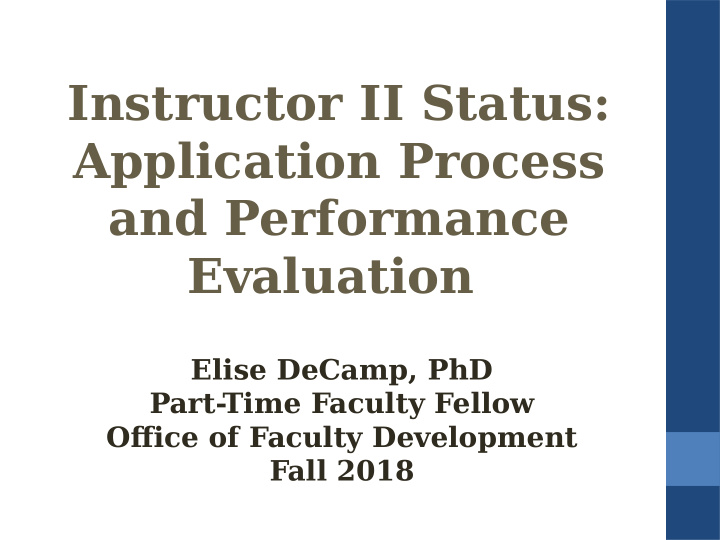



Instructor II Status: Application Process and Performance Evaluation Elise DeCamp, PhD Part- Time Faculty Fellow Ofgice of Faculty Development Fall 2018
What We Will Cover: • What is Instructor II Status? • The Application Process: Who can apply The application timeline FAQs • The Performance Evaluation: Major components Required vs. optional pieces Examples, handouts and OFD resources
Instructor II Status What is Instructor II Status? With a few rare exceptions, all part-time instructors who teach at WMU (as of Fall 2017) with no other non- instructional appointments hold Instructor I status. During the 2016 negotiations for our 2016-2021 contract, PIO bargained for the ability of PTIs who are committed to this university and its students to gain greater job security and professional recognition via applying for a new status: Instructor II. Applying for promotion to this status is optional, though strongly encouraged Beyond professional recognition, this status offers the possibility of increased pay and longer-term appointments.
Instructor II Status Benefits of Instructor II Status: Become eligible for longer-term appointments (multi- semester, multi-year) – 4 year maximum, but may be renewed Receive priority consideration for teaching appointments over those with Instructor I status Be compensated no less than any Instructor I within their department for similar work Similar work = course size or level Receive strong institutional support for pay increases In other words, pay increases are not guaranteed, but you have a stronger negotiating position
The Application Process Eligibility Requirements for Applying: Have taught at Western Michigan for 4 out of the last 5 years* *Does not need to be from only one academic unit Have taught at least 3 credits within one semester per year for 4 out of the last 5 years. Have received positive ratings on the last two annual evaluations prior to applying for Instructor II status. If no formal evaluation or observation was done and you were reappointed, that counts as a “positive” evaluation For those applying this year, physical proof of 1-2 positive annual evaluations shall be necessary.
The Application Process Application Timeline: In their fourth year of appointment (of the last five years – as many will have been here longer), an Instructor submits a written request for a Professional Competence evaluation to their academic unit chair/director. ● Must be submitted either during the Fall or by the first week of the Spring semester (January 11, 2019). Professional competence evaluation : Spring semester ● This will take the place of the annual evaluation done by the department chair/faculty committee each Spring. ● Submit file/portfolio (digital/physical) by February 1 st
The Application Process Application Timeline: Recommendations that result from the professional competence evaluation will be sent by the department chair to the Employee and the Director of Academic Labor Relations by July 15 . ● Evaluation is either positive or negative – with no loss of employability with the latter result ● Recommendation outcome is placed in the Instructor’s personnel file (in their academic unit/department) A “Positive” recommendation will result in promotion to Instructor II status, effective for a maximum period of up to four (4) years (subject to provisions of Articles 10.3(c) and 13.3 of the PIO-WMU contract).
The Application Process FAQs: Where can I find resources and examples in preparing my portfolio for the Professional Competence Evaluation? ● Office of Faculty Development – Part-Time Instructor page ● Will I still have “continuing status”? ● If you have earned continuing status by Aug 1, 2017, you will retain that until August 28, 2020. The latter date reflects the time needed for those who arrived in 2016 to be eligible to apply for Instructor II. ● How do I submit my annual evaluations? ● Contact your academic unit if you have not received letters informing you of the results of these evaluations.
Professional Competence Professional Competence Evaluation: Required Components: ● Current curriculum vitae or resumé ● Student evaluation ratings via ICES ● Annual evaluations (department/academic unit) ● Copies from past three employed years ( if on file ) ● Self-evaluation or “Narrative Statement” (4-5pp) ● Addresses only period under review ● What you include is at your discretion (see next slide) ● Selected sample of course materials ● Syllabi, assignments, exams, activities, and projects
Professional Competence Professional Competence Evaluation: Optional Components: ● Evidence of professional activities ● Includes: publications, conference presentations, workshops/trainings, and service activities ● Professional development efforts geared toward teaching effectiveness would be preferable for submission. ● Unsolicited student comments (in evaluations or emails) ● Comments from an observation of your teaching ● Those you request from OFD, your chair/director, or a fellow faculty member (Note: OFD does not complete the first-year required observations)
Professional Competence Possible self-evaluation/narrative subsections: ● Statement of Teaching Philosophy ● Connect to moments of specific courses you have taught ● Statement of Teaching Responsibilities ● Course(s) taught, student advising, student committees ● Efforts to Improve Teaching/Professional Development ● Conferences, workshops, or courses on pedagogy ● Redevelopment of Existing Courses ● Addition of innovative pedagogical strategies (e.g., role- playing, case studies); Incorporating writing or oral presentation skills; Discuss Appendix of course assignments, syllabi, projects, exams, and grading rubrics
Professional Competence Possible self-evaluation/narrative subsections (continued): ● Information from Students ● Summary of student ratings; student comments (from ICES, informal evaluations, and emails) ● Information from Colleagues ● Observations of teaching (could be recategorized under “Efforts to Improve Teaching”) ● Information from Other Sources ● Guest lectures at other universities, public lectures ● Future Teaching Goals
Professional Competence Examples and Resources: ● Sample Teaching Statements/Philosophies ● How effectively do these statements present a cohesive personal philosophy based both in pedagogical concepts and concrete examples from teaching? ● Sample Teaching Portfolio Narratives ● Aim for 4-5pp single-spaced (longer is still acceptable) ● These samples are from different disciplines – what varies between them vs. what is universal? ● What sections would you add or remove for your narrative? ● Handouts: Teaching Portfolio Checklists/Review
Recommend
More recommend